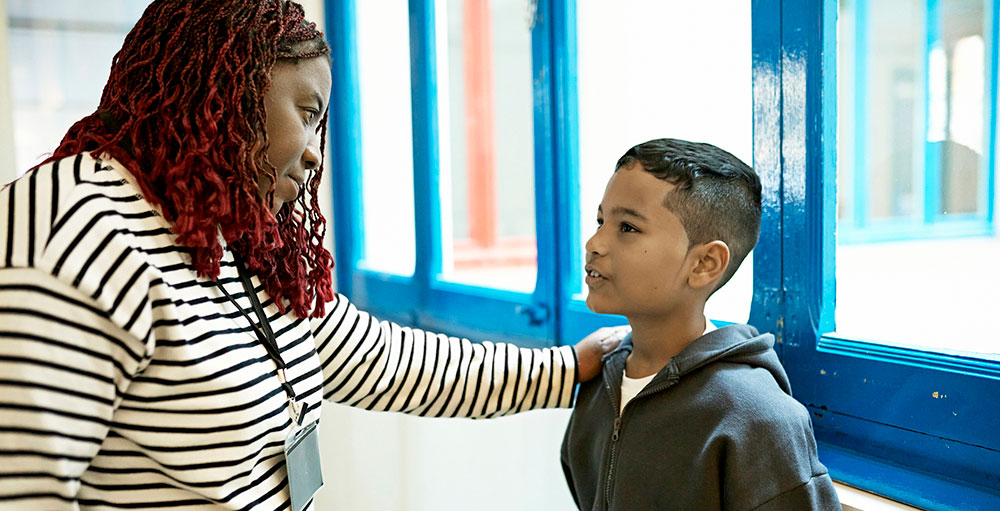
What is trauma and how does it affect the way children learn?
Trauma is a spectrum of complex reactions to events that are perceived by the individual to be dangerous, life-threatening, and exceeding their abilities and capacities to respond. Traumatic stress can arise from a variety of sources, such as abuse, neglect, loss of a loved one, or separation that impacts both children and adults. When a child experiences trauma, they might experience trouble concentrating, difficulty staying motivated, decreased ability to remain focused, increased vulnerability to distractions, difficulty following directions, difficulty with regulating emotions, troubles with completing assignments, struggles with relationships, conflict resolution, decreased attendance, increased avoidance, mood swings, or somatic symptoms (e.g., stomach distress, headaches)
What is trauma-informed education?
Trauma-informed education is a holistic systems approach that acknowledges the impact of trauma and adversity on students’ learning and behavior, while simultaneously supporting their growth and development amidst and in spite of this context. It’s a mindset and a set of practices by teachers, staff, and administrators that create a safe, supportive, and inclusive learning environment for all students. Trauma can have significant adverse effects on academic performance, social and emotional well-being, and overall development. It can also be harnessed to help students foster a better understanding of themselves and to discover their unique strengths, talents, and capabilities. At CTIE, in addition to supporting students, teachers, and administrators, we support families to equip them with tools and understanding needed to build healthy relationships and to foster a culture of excellence, in which all students thrive and have the opportunity to reach their full potential.
How does trauma impact teachers, staff, and administrators?
Teachers, staff, and administrators may experience trauma related to current circumstances and situations (e.g., person-made, natural disasters) or past experiences that stem from:
- Unreconciled early adverse childhood experiences (ACE)
- Abuse and neglect
- Domestic violence
- Family separation (e.g., divorce, incarceration, immigration, foster care)
- Grief
- Food insecurity
- Chronic medical conditions
What kinds of educational strategies are helpful to children who have experienced trauma?
Children who have experienced trauma benefit from environments where they feel seen, safe, and supported. Related, schools can craft policies, procedures, and protocols that actively promote student safety and emotional wellness. In addition, professional development workshops for teachers, staff, and administrators focusing on best practices for responding to trauma and its aftermath might be considered. Inviting parents and community partners to learn about trauma-informed campuses and encouraging their participation in the design and implementation of improved safety environments merits reflection. Lastly, providing individual support for students is key. Strategies that support students include:
- Social Emotional Learning (SEL): SEL helps children to develop self-awareness, manage emotions, experience a sense of agency and determination, build healthy relationships, increase sensitivity to others, make responsible decisions, and begin to appreciate the importance of consequences.
- Mindfulness Practices: Mindfulness activities such as breathing exercises, movement breaks, and creating a calming corner can help children feel more grounded when they feel overwhelmed, excited, or anxious.
- Strength Based Approaches: Focusing on a child's strength(s) can help build confidence and a sense of purpose. When students are encouraged to view themselves as visible, valued and appreciated, they can be more likely to engage in learning which contributes to overall success. Encouraging students to make daily positive affirmations about their abilities, talents, and special gifts is recommended.
- Referrals: Referrals to licensed mental health professionals for individual and family support.
Are there particular kinds of trauma that educators should be aware of so they can be more responsive to their students?
Traumatic events manifest differently (e.g., early childhood, domestic violence, community and school violence, medical trauma, natural disasters (e.g., earthquakes, floods, fires), epidemics, cyberattacks) and have both long term and short term impacts, some of which may not always be immediately obvious.
Are there particular groups of students who may be more vulnerable to experiencing trauma?
No one is immune to trauma. However, certain groups of students may have increased exposure to traumatic stress due to individual circumstances or situations such as:
- Students in foster care
- LGBTQ+ students
- Students living in poverty
- Immigrants or Immigrant families
- Religious communities
- Students who come from domestic or community violence
- Students unhoused
- Students with disabilities
- Students with chronic medical conditions
Who does your organization serve?
CTIE partners with schools and districts in Los Angeles and communities in the surrounding region to meet the needs of students, teachers, administrators, and parents/guardians.
In what ways does the Center for Trauma Informed Education work with different groups?
CTIE partners with a wide range of public, charter, and faith-based schools across Southern California to support trauma informed practices and promote student, staff, teacher, and administrator well-being. CTIE offers professional development workshops, responds to requests for consultation, and invites partner schools and community members to explore the list of resources on the CTIE website.
How can my school or district collaborate with CTIE?
If your school or district is interested in partnering with CTIE, please reach out to us via email at ctie@lmu.edu.